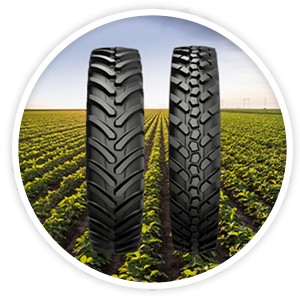Conversion options: from standard to narrow tyres
On the basis of a practical example, we would like to show you all the things you need to consider when converting an agricultural tractor to narrower tyres. The dimensions/data of the tyres mentioned can all be found in the technical section of the Heuver Agricultural Tyre Book. Of course, we do not forget to look at the corresponding rims.

Conversion to cultivated tyres
The questions that need to be asked beforehand are:
- Which tractor is involved (precise indication of make and type)?
- What tyres are fitted (standard ex-factory)?
- What width should the desired cultivation tyres be?
- What is the desired track width for the tractor?
The corresponding answers in this case are:
- Fendt 724 Vario S4 / with a fixed rear axle
- Standard tyres: 540/65R30 and 650/65R42 Trelleborg TM800
- Desired tyre width is 380mm (front and rear)
- Desired track width is 2000mm
Based on this information, we proceed as follows:
- First, we gather the tractor's technical data (axle width, pitch circle, gear ratio, and so on).
- Also, as a first orientation, we look in the conversion table, if we do not yet know the most suitable tyre combination directly.
We then take the following steps:
What is the diameter of the rear tyres?
- Rear tyre 650/65R42 Trelleborg TM800 has a diameter of 1927mm.
We take this diameter (plus a few extra millimetres) as a starting point to find the matching tyre with a width of 380mm. In this case, we now take a 380/90R50 Barkley BLA08 for the rear axle. This, in fact, has a diameter of 1954mm.
To find the, based on the front run, suitable front tyre, we need the gear ratio of the agricultural tractor. For the Fendt 724 Vario S4, this is 1.3222. The 380/90R50 Barkley BLA08 has a rolling circumference of 5808mm.
If we now divide the rolling circumference of the rear tyres by the gear ratio, we get the result of the minimum rolling circumference, which the front tyres you are looking for must have.
So: 5808mm / 1.3222 = 4392mm
In that case, there is exactly 0% travel and we assume in this example that the required travel should be between 0% and 3%.
So: 4392mm + 3% = 4525mm
This means that the front tyre must have a rolling circumference of between 4392mm and 4525mm. Next, we end up with the 380/85R34 Barkley BLA01 with a rolling circumference of 4518mm.
Now that we have found the right tyres, we just need to find the matching rims with the right ET value to get to the desired track width of 2000mm.
Front axle:
380/85R34 Barkley BLA01 - the recommended rim for this is W12x34. The agricultural tractor has an axle width of 1900mm, but we want to go to a track width of 2000mm. That means, that we need to move 50mm further out on both sides, with which we need rims with an ET value of -50. The pitch circle in this case becomes: 10 / 281 / 335 / 22mm cylindrical.
Rear axle:
380/90R50 Barkley BLA08 - the recommended rim for this is TW13x50. The agricultural tractor has an axle width of 1840mm, but again we want to go to a track width of 2000mm. That means, that we need to move 80mm further out on both sides, with which we need rims with an ET value of -80. The pitch circle in this case becomes: 10 / 281 / 335 / 24mm cylindrical.
All in all, this makes the new tyre-on-wheel combination for this farm tractor:
- 380/85R34 Barkley BLA01 on rim W12x34 ET -50 and
- 380/90R50 Barkley BLA08 on rim TW13x50 ET -80
Like to know more?
Do you need advice? Please contact us, our experts will be pleased to assist you. Contact our experts at +31 (0)523 - 850 850 or by e-mail to info@heuver.com. You can also read all about agriculture on the agricultural knowledge-page.

